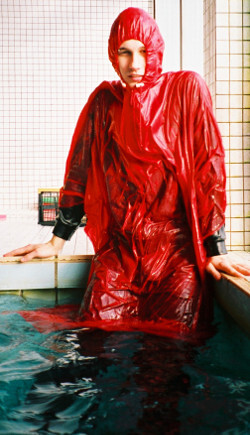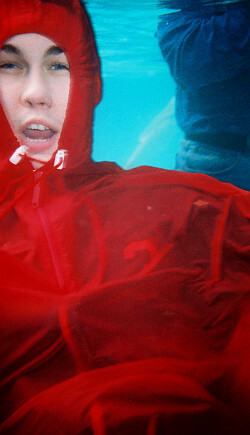Ponchos and Capes
Ponchos and capes are very practical with more versatility and ventilation than a rain suit, a fantastic accessory for rainy days, or UV sun protection.
They offer excellent protection against the elements while being easy to use, practical, cost-effective, and environmentally friendly. So next time it rains, consider reaching for your trusty rain cape.
Ponchos and capes are not only stylish but also incredibly functional when it comes to dealing with wet weather conditions. Unlike rain suits that can be restrictive and hot to wear, ponchos and capes allow for greater ventilation and movement due to their lightweight design.
They drape over the body like a cloak, providing protection from both front and back while still allowing air circulation around the wearer's body. This makes them an ideal choice for outdoor activities in rainy environments where staying dry is essential but overheating can be just as problematic.
Additionally, their versatile nature means they can be worn not only during rain showers
but also as a fashion statement on sunny days or even at formal events,
making them a must-have accessory for any wardrobe.
Ponchos? Capes? What's the Difference?
There is often some confusion of what is a cape, poncho, or pelerine. We seek to clarify this and share with you how comfy and versatile these outfits are.
Ponchos and capes are both considered common types of outerwear even today, but the two are often confused for one another because of how similar they are. The main difference between the two styles is the design of each type as well as the purpose for which it is worn.
Ponchos
Ponchos are a square cloth with a hood in the middle, open on the sides with buttons. They are most versatile for camping, hiking, and swimming.
Capes
Capes are more bell shaped with closed sides.
Some have sleeves, most have arm openings near the front.
Capes with sleeves are easy to swim in,
unlike the ones without sleeves that keep the arms inside.
Traditionally, capes were a fashion item while ponchos are worn to protect from the elements.
How are Hiking Capes different?
Hiking Capes are longer in the back and closed on the sides, with short or long sleeves. Useful for walking, hiking and swimming, but maybe too large for cycling.
The closed design can be more convenient than a poncho because it doesn't require constant adjusting to stay on. It provides additional warmth and insulation compared to traditional ponchos.
Sleeves
Hiking capes with sleeves are not as common as those without, but they do exist. While not all hiking capes have sleeves, they can be a great option if you want freedom to move your arms with the benefits of a cape design.
Having sleeves can be beneficial during hiking or camping or when engaging in activities that require arm movement, like hiking with poles. They also help keep your arms dry from rainwater dripping down from the cape's fabric.
Do not wear your poncho or rain cape in moving water, like when fording a river or in surf.
That could be dangerous.
History
Ponchos and capes were adopted as overcoat in the eighteenth century and were more country wear than urban. They were very popular in the past due to their ease of construction and their ability to be re-cut and used for other garments. When cloth was hand woven and all sewing was done by hand these were important factors.
As weaving moved from households to mills the price of cloth fell and the invention of the sewing machine made more intricate outerwear available to most people.
Today, many adolescents and younger adults discovered the benefits of rain capes. Our older readers know them from their youth and still appreciate them years later. Countless people and whole families go hiking, walking or enjoy long treks in the rain.
Ponchos and capes are still the most reliable rain protection. They dry quickly as they don't soak up much water. The combination with rain pants is unbeatable. This means you can wear them anywhere, any time, even in the water.
Being completely open at the bottom, they don't trap your body sweat the way waterproof jackets and pants inevitably do. The length can be anywhere from the thigh to the ankles.
Materials
Due to the need for both water-resistance and breathability, these garments often use specialized materials that balance those two requirements. The materials used for these capes are often similar to those found in waterproof jackets, ensuring both water-resistance and breathability.
The nylon fabric is lightweight for hotter days or splashing around.
Some smart people found them useful as sun protection on the beach or when swimming.
They also make a handy changing room on the beach.
Alternative Uses
Creative people have found other uses for a poncho or cape. When relaxing at home on cool days lightweight a cape is less bulky than a blanket.
A swim poncho keeps you warm during training breaks. It is designed to get wet so you can wear it over your swim clothes.
On sunny days a breathable hiking cape with good ventilation avoids sunburn. It looks good around town, on the beach, or in the pool. Sun Capes are loose fitting and airy, comfy to wear and versatile as changing room or for swimming when you forgot your swimwear. The attached hood won't get lost unlike a sun hat.
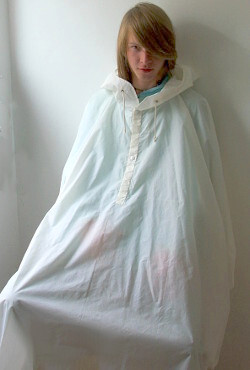
Cosy cape for cool days at home
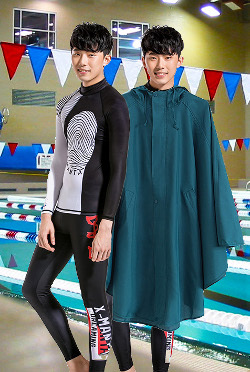
Warm-up poncho on poolside
Clothes for Underneath
Ponchos and rain capes work best when worn over quick drying, functional clothing. Remember, you will get wet either from rain or your own sweat. Cargo pants or breathable nylon rain pants with pockets complete this outfit. Lycra tights may work for cycling or swimming, but not so much for hiking. Avoid cotton as it gets cold and clammy when wet.
Depending on the climate you may want to wear extra layers underneath your cape or poncho. A loose fit swim shirt is good for ventilation in hot weather. It keeps the poncho from sticking to your skin, allows it to slide over you as you move about.
A tight fleece shirt keeps you warm in cool weather. It soaks up moisture off your skin and evaporate, or passes it to the poncho.
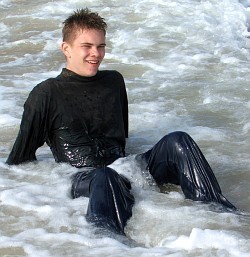

Pool Training
Before you head out for the great outdoors, wear your entire hiking outfit under the shower to detect leaks. Then go into a swimming pool to see how these clothes perform in the water. This avoids later disappointment.
- Do they fit well, stay put and feel good?
- Is it easy to wade through the water?
- Can you swim in these clothes?
- Does the hood fit well or obstruct your vision?
Keen outdoor enthusiansts practice swimming in their hiking kit so they are ready for wet adventures.
This is good fun, builds strength and endurance,
and prepares for the inevitable swim or water crossings.
What may seem like an enjoyable but ultimately silly pool activity
could save your life one day in an emergency.
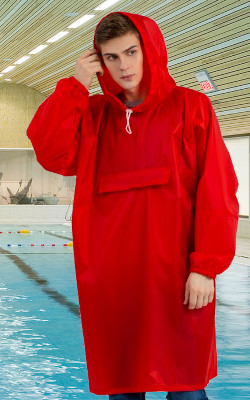
Smart folks practice in the pool.
